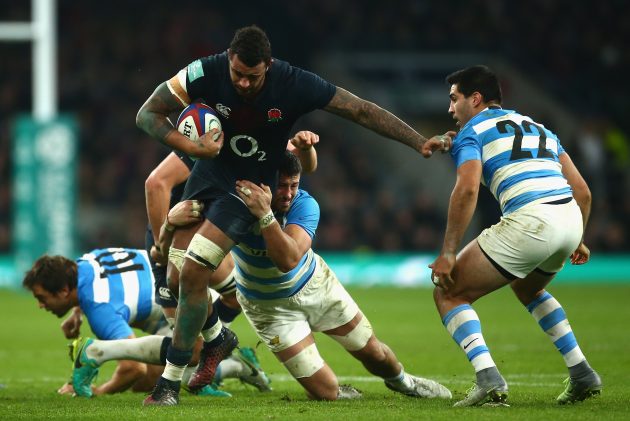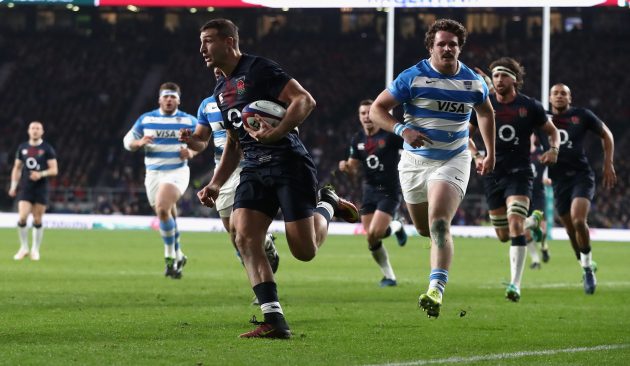By Alex Shaw
If you were still awaiting that elusive, complete performance from England under Eddie Jones, that idealised 80 minutes of rugby where every facet of their game comes together and they put the opposition to the sword, your wait continued this weekend. What occurred on Saturday, when England beat Argentina 27-14 at Twickenham, was, however, the best performance that the hosts have turned in under the tutelage of the Australian. Or at least in the opinion of this writer.
Having been reduced to 14 men when Elliot Daly saw red in the 5th minute of the game, England faced an uphill battle for the remaining 75 minutes but dealt with the challenge through a combination of outstanding defence, an efficient lineout and good game management.
We run through five of the key takeaways for Jones and his coaching staff from an entertaining and dramatic encounter on Saturday afternoon.
Back three balance
It is fair to say plenty of eyebrows were raised by the omission of Semesa Rokoduguni for this match and, to a lesser extent, the decision to also send Alex Goode back to his club. Jonny May and Mike Brown returned to the XV and both put on masterful performances under extremely difficult circumstances.
Where the issues in the back three came were on the left wing, where outside centre Daly was made to look like a man playing out of position. His collision with an in-air Leonardo Senatore bore no malice or intent but it was a justified red card.

Long walk: Elliot Daly leaves the field after his red card
Chasing and competing for kicks is a skill that wingers practice relentlessly over their careers but it is not something centres will spend anywhere near as much time on training ground working on.
Jones may have compared Daly to Jason Robinson in the week running up to the game and his potential in the back three is clear but the Test arena is not the ideal place to be learning and developing these skills.
Return of Kruis
Kruis’ return from injury was critical to – and representative of – a much-improved defensive performance from England.
With Kruis, Maro Itoje and James Haskell all missing against South Africa and Fiji, England were shorn of three of their most vocal and effective defensive communicators. At times versus both of those sides, Chris Robshaw and Owen Farrell were lone voices trying to organise their side’s defence, both at the ruck and further out.
The Saracens lock did not miss a beat in his first game back from ankle surgery and reassumed his mantle of a defensive general within the England set-up. He helped take England’s driving lineout to the next level, too, which helped them control the clock and sap energy from an Argentinean side that had a man advantage for most of the game.
It’s a bold assumption, but I don’t think England win this game without the defensive nous of Kruis back in the second row.
It was also a coming of age game for Paul Gustard as a Test coach.

Big pressence: Courtney Lawes attracts Argentine defenders
England developing ‘plug and play’ depth
If the All Blacks are lauded for one thing above all others, it’s arguably their ability to plug and play back-ups, young budding stars or even long-time journeymen into their first-choice squad and still maintain their high level of performance.
It’s something that England are taking strides with in each game that passes under Jones’ stewardship.
Courtney Lawes has epitomised this in his showings over the autumn, not least so against Argentina at the weekend. His forcible tackles prevented Argentina from getting over the gain line and breaking open an England defence that was stretched numerically for 70 minutes.
Everyone expects Maro Itoje to take the jersey back when he returns to fitness and he should, but it’s worth noting his replacement has done everything that has been asked of him.
Similarly, the likes of Tom Wood, Teimana Harrison, Rokoduguni, Goode and Daly – at outside centre – have all fitted in well when called upon this month. There have not been the signs of disruption or a lessening in quality that have accompanied England’s injury-enforced changes in years gone by.
With Itoje, Haskell, Anthony Watson and Jack Nowell all to return in the coming months, Manu Tuilagi already back in Leicester’s team and the uncapped and currently injured duo of Sam Jones and Mike Williams in England’s sights, Jones’ depth of options continues to grow.
Highs, lows and more inconsistency at the scrum
The scrum has been an unpredictable aspect of England’s play in 2016.
It has ranged from a powerful unit capable of dominating to an Achilles’ heel that has plagued England’s desire to put speed and width on the ball. It was no different against Argentina.
The front row of Mako Vunipola, Dylan Hartley and Dan Cole struggled to deal with Argentina in the first half, with the Pumas having a clear advantage. This is not a vintage Argentinean scrummaging front row, either, but anytime you have to deal with a bajada-employing Pumas pack spearheaded by the talented Agustín Creevy, it’s an area of the game where you can be found wanting.
England struggled to strike the ball quickly and hold up to the pressure that the Argentineans were exerting on them, something which culminated in Cole being sent to the sin-bin late in the first half.
It should be noted this improved dramatically when Joe Marler and Jamie George joined Cole in the front row in the second half, albeit against the second-string Argentinean front row. George was quickly able to get his heel to the ball and then focus on shifting his weight and power to moving the scrum forward.
The Saracens front rower is continuing to bang on Jones’ door with all the gusto of a, well, hungry hooker.

Numbers game: Argentina failed to make any advantage count
Argentina’s woes
For all the eulogising that England’s defence and resilience deserves from that game, Argentina coach Daniel Hourcade has every right to be incensed by his side’s performance.
The match may have finished with 13 men versus 13 men, but for vast swathes of it, Argentina had one or two-men advantages and come the end of 80 minutes, it was the Pumas that looked out on their feet, whilst England’s line speed in defence continued to cause them problems.
With England having to make three times the amount of tackles Argentina did, there was no excuse for the lack of problems Argentina were able pose England, with the last few minutes of the first half and the first few minutes of the second half the obvious exceptions.
It’s been a long and draining season for the Pumas but the handling mistakes, decision-making errors and poor one-on-one tackling all fell well below the standards that the Argentinean players usually hold themselves to.





